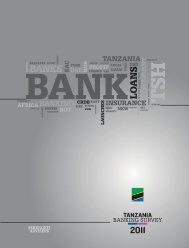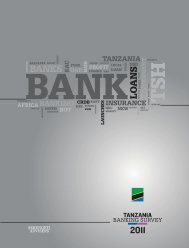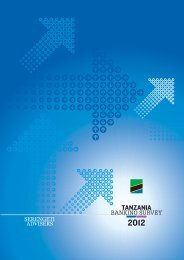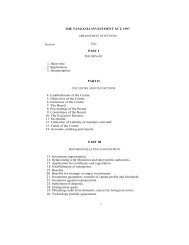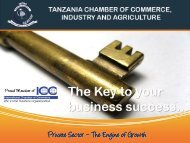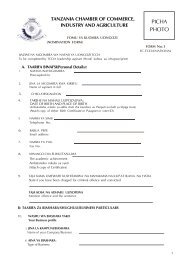Tanzania Cotton Board Annual Report And Accounts
Tanzania Cotton Board Annual Report And Accounts
Tanzania Cotton Board Annual Report And Accounts
Create successful ePaper yourself
Turn your PDF publications into a flip-book with our unique Google optimized e-Paper software.
FINANCIAL STATEMENTS<strong>Annual</strong> <strong>Report</strong> and <strong>Accounts</strong> for the year ending on 30 th June 2010(o) PayablesPayables are recognized initially at fair value and subsequently measured at amortizedcost using the effective interest method.3 FINANCIAL RISK MANAGEMENT3.1 Financial Risk FactorsThe <strong>Board</strong>’s activities expose it to a variety of financial risks: foreign currency risk,credit risk, and liquidity risk. The <strong>Board</strong>’s overall risk management plan seeks tominimize potential adverse effects on the <strong>Board</strong>’s financial performance. Risksmanagement is carried out by the management under the policies approved by the<strong>Board</strong> of Directors.Foreign Currency RiskThe <strong>Board</strong>’s exposure to foreign exchange risks arises from rental income, purchases,assets and liabilities denominated in currency other than the functional currencymainly with respect to the US dollar. At the year end, the <strong>Board</strong> has financial assetsand liabilities denominated in United States Dollars (USD). As a result, the <strong>Board</strong> issubject to transaction and translation exposure from fluctuations in foreign currencyexchange rates. Exposure to foreign currency risk is mitigated by the fact that the<strong>Board</strong> maintains certain part of its income in US Dollars bank accounts. The effectof foreign currency risk is not significant and therefore management does not hedgeagainst foreign currency risk.Credit RiskCredit risk arises from trade receivables, cash and cash equivalents as well asdeposits with banks. Significant concentration of credit risk is with rental receivables.A significant part of the trade and other receivable is made up of customers occupyingthe <strong>Board</strong>’s investment properties. Based on <strong>Board</strong>’s policy, management has madeadequate provision where the recoverability is doubtful. Only reputable banks areused by the <strong>Board</strong> for banking services. The amount that best represents the <strong>Board</strong>’smaximum exposure to credit risk at 30 June 2009 is made up as follows:2009/2010 2008/2009TZSTZSCash at bank 3,297,359,255 1,983,885,213Trade receivables 489,399,535 433,396,090VAT receivable 11,313,035 42,950,247Staff debtors 38,115,310 41,193,733Receivable from a related party - 290,378,212Other receivables 16,668,809 12,934,1983,852,855,944 2,804,737,693No collateral is held for any of the above assets. The company does not grade the creditquality of receivables. All receivables that are neither past due nor impaired are within theirapproved credit limits, and no receivables have had their terms renegotiated.33



